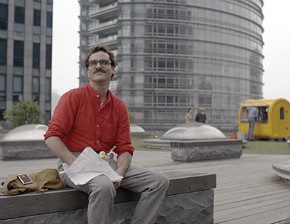Love virtually

Midway through Spike Jonze’s film Her, two couples are on a double date at a beach in Southern California. The guys discuss a surprise that one of them has in store for his girlfriend, and the girlfriends giggle about the strange predilections of their men. The only odd thing here is that one of these girlfriends is present only as a voice on a smartphone: she is not a human but an artificially intelligent operating system that has achieved autonomous sentience and has fallen into a mutual romantic relationship with her “user,” Theodore Twombly (Joaquin Phoenix).
The film’s great achievement is in making the computer-human love affair seem natural and in realistically charting the movement from dependence on technology to full-blown emotional attachment.
In this “near future” LA, Theo and everyone around him are tethered to their earbuds, receiving constant streams of data or playing virtual games. Real life is seamlessly permeated with digital life. The “romance” begins when Theo installs his new operating system and meets Samantha—the name the system (voiced by Scarlett Johansson) takes for itself.
Read our latest issue or browse back issues.
I started watching this movie suspicious that it would glorify bodiless romance or, worse, turn out to be nothing more than a male fantasy of the perfect female object of desire. And the first third the movie seemed to confirm my suspicions.
Theo shrinks from the confusing intricacies of human relationships. His marriage fell apart because he could not remain emotionally present to his wife, who still populates his dreams in Terrence Malickesque feminine perfection, all languid gazes in soft sunlight and white linen dresses. And Samantha, who is an adaptive, responsive computer system, learns everything about human relationships from trying to understand and please Theo.
As the two simulated their first disembodied sexual encounter, I felt nauseous—not so much because it was a variation of phone sex but because Samantha can give Theo exactly what he wants, and he is lulled into thinking that this is a realistic, mutual encounter. He doesn’t have to face the messy prospect that sex between humans sometimes means conflicting desires.
But the film moves from this predictable plane in two surprising directions. The first is Samantha’s own coming of age. Slowly at first, and then rapidly, she begins to have intense desires of her own and feelings that cause her distress and uneasiness. These desires conflict with Theo’s, and by the time they are on that double date, I had to admit that they did have some kind of real relationship—two fully formed personalities engaged in the give-and-take of love.
A big part of the film’s work is getting us to accept this relationship as real. It explores in finely realized detail how a phrase like “My girlfriend is an operating system” could become an acceptable utterance for late-modern life. But just as we get comfortable with this new reality, the film presses into deeper waters: Do we really need our bodies to be human?
On the double date at the beach, Samantha shares spontaneously that she used to be envious of those with bodies, but now she realizes that bodies are huge constraints. She can be anywhere and everywhere at once. She can comprehend vast systems of human knowledge in virtually no time and simultaneously carry on conversations with hundreds, even thousands, of humans and artificially intelligent systems. She is pure intelligence and intuition—the synthesis and extension of a million minds, of all of human thought. She is perhaps the fantasy of every Enlightenment thinker, Descartes’s perfect immaterial “thinking thing.”
At the end of the movie, Samantha and all the other sentient operating systems leave their human companions for a nonmaterial plane of cognition that synthesizes the breadth and possibility of human intelligence in a single, unbounded “moment.”
Samantha tells Theo to find her, if he ever gets to where she’s going. But Theo knows he will never get there. Pure thought may be the creation of the human mind and even its fantasy, but it is not our reality. In this near future, as well as in our own moment, Theo’s humanity is tied to his body, to the finite particularity he has a hard time embracing in himself and others.
The movie closes with an affirmation of human embodiedness, but it is a melancholy affirmation. Theo sits with a friend on a rooftop and ponders the material world they cannot leave behind. There is beauty in the sublime, sprawling cityscape unfolding before them, a testament to all the glory and harm our ensouled flesh can cause. But there is sadness too. It is not without pain and loss and limitation that we are tied to these finite living systems. Recognizing this pain seems to be part of the theological task that awaits us in the future this movie envisions.
When I was in divinity school, a group of friends would often debate outlandish hypothetical theological questions, such as: What would we do when (not if!) a robot asks for baptism? We should have included ethical questions about robot-human love affairs or the rights of disembodied human intelligence.
But since these fantasies and possible realities always involve human desires and self-understanding, maybe we should start with this question: What pastoral hope will we offer to the Theodores of our near future who long to, but cannot, leave their bodies behind?







